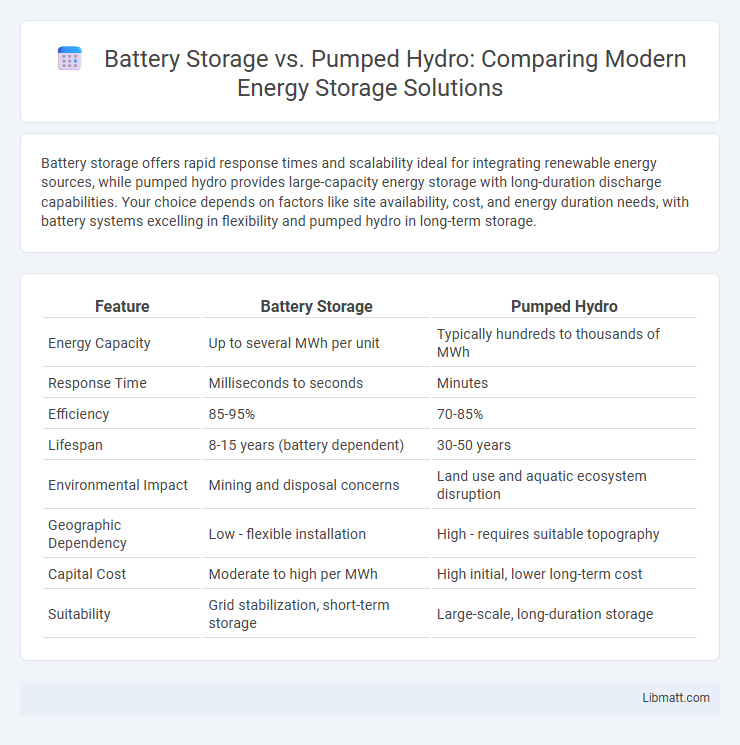Battery storage offers rapid response times and scalability ideal for integrating renewable energy sources, while pumped hydro provides large-capacity energy storage with long-duration discharge capabilities. Your choice depends on factors like site availability, cost, and energy duration needs, with battery systems excelling in flexibility and pumped hydro in long-term storage.
Table of Comparison
| Feature | Battery Storage | Pumped Hydro |
|---|---|---|
| Energy Capacity | Up to several MWh per unit | Typically hundreds to thousands of MWh |
| Response Time | Milliseconds to seconds | Minutes |
| Efficiency | 85-95% | 70-85% |
| Lifespan | 8-15 years (battery dependent) | 30-50 years |
| Environmental Impact | Mining and disposal concerns | Land use and aquatic ecosystem disruption |
| Geographic Dependency | Low - flexible installation | High - requires suitable topography |
| Capital Cost | Moderate to high per MWh | High initial, lower long-term cost |
| Suitability | Grid stabilization, short-term storage | Large-scale, long-duration storage |
Introduction to Battery Storage and Pumped Hydro
Battery storage systems store electrical energy in chemical form, enabling rapid discharge and scalability for grid stabilization and renewable integration. Pumped hydro storage utilizes gravitational potential energy by moving water between two reservoirs at different elevations, offering large-scale, long-duration energy storage with high efficiency. Your choice depends on factors like site availability, energy capacity needs, and response time for balancing supply and demand.
How Battery Storage Systems Work
Battery storage systems store electrical energy chemically within cells composed of anodes, cathodes, and electrolytes, enabling rapid charge and discharge cycles. These systems convert electrical energy into chemical energy during charging and reverse the process during discharging to supply power on demand. Your ability to deploy battery storage offers flexibility for grid stabilization, peak load management, and integration with renewable energy sources.
Understanding Pumped Hydro Storage
Pumped hydro storage utilizes two reservoirs at different elevations to store energy by pumping water uphill during low demand and releasing it to generate electricity when needed. This method offers large-scale, long-duration energy storage with high efficiency and durability compared to battery storage, which is typically suited for shorter-term and smaller-scale applications. Understanding pumped hydro's role can help you optimize energy management by leveraging its capacity for grid stability and peak load balancing.
Efficiency Comparison: Battery vs Pumped Hydro
Battery storage systems typically offer round-trip efficiencies between 85% and 95%, surpassing pumped hydro which averages around 70% to 80%. Lithium-ion batteries excel in rapid energy discharge and high cycle efficiency, making them ideal for short-duration storage. Pumped hydro, while less efficient, provides large-scale energy storage capacity and longer discharge durations, suitable for grid-level applications.
Cost Analysis: Installation and Maintenance
Battery storage systems typically involve higher upfront installation costs but benefit from lower ongoing maintenance expenses due to fewer mechanical parts. Pumped hydro facilities require significant capital investment in construction, often involving complex civil engineering works, and incur higher maintenance costs related to pumps, turbines, and reservoirs. Your choice depends on balancing initial expenditure with long-term operational costs and project scale.
Environmental Impact and Sustainability
Battery storage systems often rely on lithium, cobalt, and nickel, which involve environmentally intensive mining processes affecting ecosystems and water resources. Pumped hydro storage utilizes gravitational potential energy with minimal emissions during operation and generally has a longer lifespan, but it can lead to significant land use changes, habitat disruption, and altered water flows impacting aquatic ecosystems. Sustainable energy storage decisions balance the finite material extraction challenges of batteries against the ecological footprint and geographical limitations of pumped hydro infrastructure.
Grid Flexibility and Scalability
Battery storage systems provide rapid response times and modular scalability, enabling seamless integration of renewable energy into the grid while supporting frequency regulation and peak load management. Pumped hydro offers large-scale energy storage with high efficiency and long discharge durations, ideal for stabilizing grid supply over extended periods but limited by geographical constraints. Your choice depends on the required grid flexibility, with batteries excelling in fast, scalable deployments and pumped hydro delivering bulk energy storage for long-term stability.
Geographic and Site Requirements
Battery storage systems require minimal geographic space and can be installed in a variety of locations, including urban areas, making them highly versatile for decentralized energy storage. Pumped hydro storage demands specific geographic conditions such as significant elevation differences, ample water availability, and suitable reservoirs, typically limiting sites to mountainous or hilly regions with adequate environmental impact considerations. The geographic flexibility of battery storage contrasts with the site-specific constraints of pumped hydro, influencing project feasibility and development costs.
Applications in Renewable Energy Integration
Battery storage systems offer rapid response and scalability, making them ideal for balancing short-term fluctuations in solar and wind energy output. Pumped hydro storage, with its large capacity and long-duration energy retention, is suited for grid-scale renewable integration, providing stable baseload power and peak load management. Both technologies complement renewable energy integration by enhancing grid reliability and enabling higher penetration of intermittent energy sources.
Future Trends and Innovations in Energy Storage
Battery storage technology is rapidly advancing with innovations such as solid-state batteries and improved lithium-ion chemistries enhancing energy density and charging speed. Pumped hydro storage, benefiting from smart grid integration and AI-driven predictive maintenance, remains a cost-effective solution for large-scale, long-duration energy storage. Your energy strategy can leverage these future trends by combining the flexibility of next-gen batteries with the reliability of pumped hydro to optimize grid stability and renewable integration.
Battery Storage vs Pumped Hydro Infographic

 libmatt.com
libmatt.com